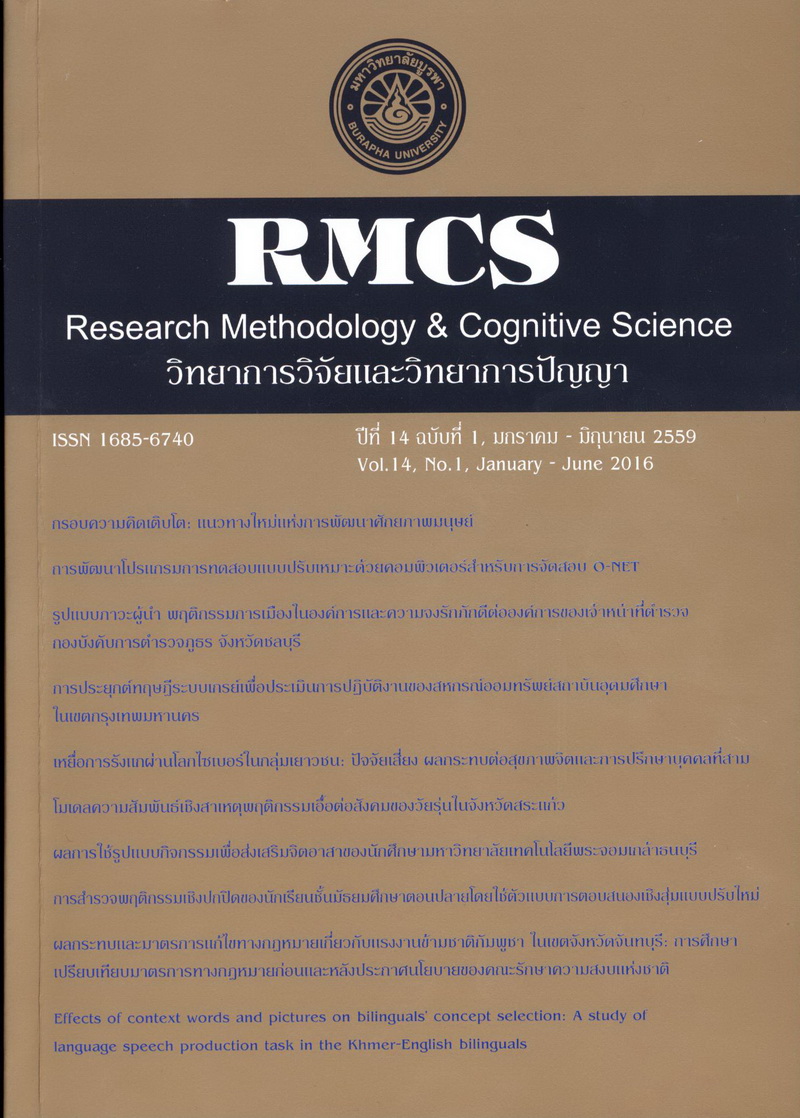การประยุกต์ทฤษฎีระบบเกรย์เพื่อประเมินการปฏิบัติงานของสหกรณ์ออมทรัพย์ สถาบันอุดมศึกษาในเขตกรุงเทพมหานคร
Main Article Content
Abstract
การวิจัยนี้มีวัตถุประสงค์เพื่อประยุกต์ทฤษฎีระบบเกรย์ส าหรับใช้ในการประเมินการปฏิบัติงานของ
สหกรณ์ออมทรัพย์ของสถาบันอุดมศึกษาในเขตกรุงเทพมหานคร จ านวน 13 แห่ง การประเมินใช้ตัวชี้วัดเชิงคุณภาพ
SMAARTS ซึ่งประกอบด้วยตัวชี้วัด 7 ด้าน มีผู้ทรงคุณวุฒิที่ได้รับการยอมรับในวงการสหกรณ์จ านวน 5 คน
เป็นผู้ประเมินตามวิธีการของ Rahimnia, Moghadasian and Mashreghi (2011) และ Rajesh and Ravi (2015)
ผลการวิจัยปรากฏว่า 1) ตัวชี้วัดด้านความเชื่อมั่นของสมาชิก [0.78 , 0.96]) มีความส าคัญมากที่สุด ถัดมาคือ
ด้านการจัดการ [0.72 , 0.89] ด้านโครงสร้างการบริหาร [0.70 , 0.88] ด้านระเบียบปฏิบัติ [0.68 , 0.82]
ด้านความพอเพียง [0.68 , 0.82] ด้านสินทรัพย์ [0.64 , 0.86] และด้านความเสี่ยง [0.58 , 0.72] ตามล าดับ และ
2) ผลการประเมินการปฏิบัติงานของสหกรณ์ออมทรัพย์ ชี้ให้เห็นว่ามีสหกรณ์ 6 แห่ง ที่การปฏิบัติงานอยู่ในระดับสูง
มีสหกรณ์ 2 แห่ง ที่การปฏิบัติงานอยู่ในระดับปานกลาง มีสหกรณ์ 4 แห่ง ที่การปฏิบัติงานควรปรับปรุง และมีสหกรณ์
1 แห่ง ที่การปฏิบัติงานควรปรับปรุงอย่างเร่งด่วน
Application of Grey system theory to evaluate performance in savings and credit cooperatives of higher education institutions in Bangkok
The objective of this research was to apply Grey system theory for evaluating the
performance of 13 savings and credit cooperatives of higher education institutions located in
Bangkok. Seven qualitative indicators called “SMAARTS” was used in the evaluation. There
were five experts evaluated the performance based on Rahimnia Moghadasian and Mashreghi
(2011), and Rajesh and Ravi (2015) approaches. The results showed that (1) Trust indicator [0.78
, 0.96] was the most important. The other variables were Management [0.72 , 0.89], Structure
[0.70 , 0.88], Agreement [0.68 , 0.82], Sufficiency [0.68 , 0.82], Asset [0.64 , 0.86], and Risk
[0.58 , 0.72] consequently, and (2) according to the performance evaluation, the results of the
savings and credit cooperatives were found that six of them performed at high level, and two of
them performed at medium level. However, there were four savings and credit cooperatives
where should improve the performance and one savings and credit cooperative where should urgently
improve the performance.
Article Details
References
กรมตรวจบัญชีสหกรณ์. (2552). รายงานฉบับสมบูรณ์โครงการพัฒนาระบบประเมินประสิทธิภาพการด าเนินงาน
ของสหกรณ์ออมทรัพย์ด้วยแบบจ าลอง Data Envelopment Analysis. เข้าถึงเมื่อ 6 กันยายน 2557.
เข้าถึงได้จากhttp://www.cad.go.th/ewtadmin/ewt/statistic/download/dea51_final.pdf
กรมตรวจบัญชีสหกรณ์. (2558). ภาวะเศรษฐกิจภาคสหกรณ์ไทย ปี 2557 และสารสนเทศน่ารู้. กรุงเทพมหานคร:
ส่วนวิจัยและพัฒนาสารสนเทศทางการเงิน.
ประสพชัย พสุนนท์ สุดา ตระการเถลิงศักดิ์ และวลัยลักษณ์ อัตธีรวงศ์. (2558). “การคัดเลือกข้อความของตัวชี้วัด
เชิงคุณภาพ SMAARTS ส าหรับใช้ประเมินประสิทธิภาพการด าเนินงานของสหกรณ์ออมทรัพย์: การพัฒนา
และคัดเลือกด้วยวิธีการเดลฟายฟัซซี.” วารสารวิชาการ มหาวิทยาลัยกรุงเทพธนบุรี, 4(1) , 74 – 87.
วิรัช วิรัชนิภาวรรณ. (2552). การบริหารจัดการของหน่วยงานของรัฐ: การวิเคราะห์เปรียบเทียบตัวชี้วัด.
กรุงเทพมหานคร: ส านักพิมพ์โฟรเพซ.
ส านักส่งเสริมและพัฒนาสหกรณ์. (2554). ค าแนะน าการจัดระดับมาตรฐาน ประจ าปี 2554. เข้าถึงเมื่อ 16
พฤษภาคม 2557. เข้าถึงได้จาก http://webhost.cpd.go.th/cepocpd/standard_54.html
Deng, J. L. (1989). Introduction to Grey system theory. The Journal of Grey System, 1(1), 1 – 24.
Hsu, Y. L., Lee, C. H. & Kreng, V. B. (2010). The Application of fuzzy Delphi method and fuzzy AHP
in lubricant regenerative technology selection. Expert Systems with Applications. 37(1),
– 425.
Li, G. D., Yamaguchi, D. & Nagai, M. (2007). A Grey-based decision-making approach to the supplier
selection problem. Mathematical and Computer Modelling. 46(3-4), 573 - 581.
Lin, Y., Chen, M. & Liu, S. (2004). Theory of Grey systems: Capturing uncertainties of Grey
information. Kybernetes. 33(2), 196 - 218.
Rahimnia, F., Moghadasian, M. & Mashreghi, E. (2011). Application of Grey theory approach to
evaluation of organizational vision. Grey Systems: Theory and Application, 1(1), 33 – 46.
Rajesh, R. & Ravi, V. (2015). Supplier selection in resilient supply chains: A grey relational analysis
approach. Journal of Cleaner Production, 86(1), 343 – 359.
Yin, M. S. (2013). Fifteen years of Grey system theory research: A historical review and bibliometric
analysis. Expert Systems with Applications, 40(7) , 2767 – 2775.

